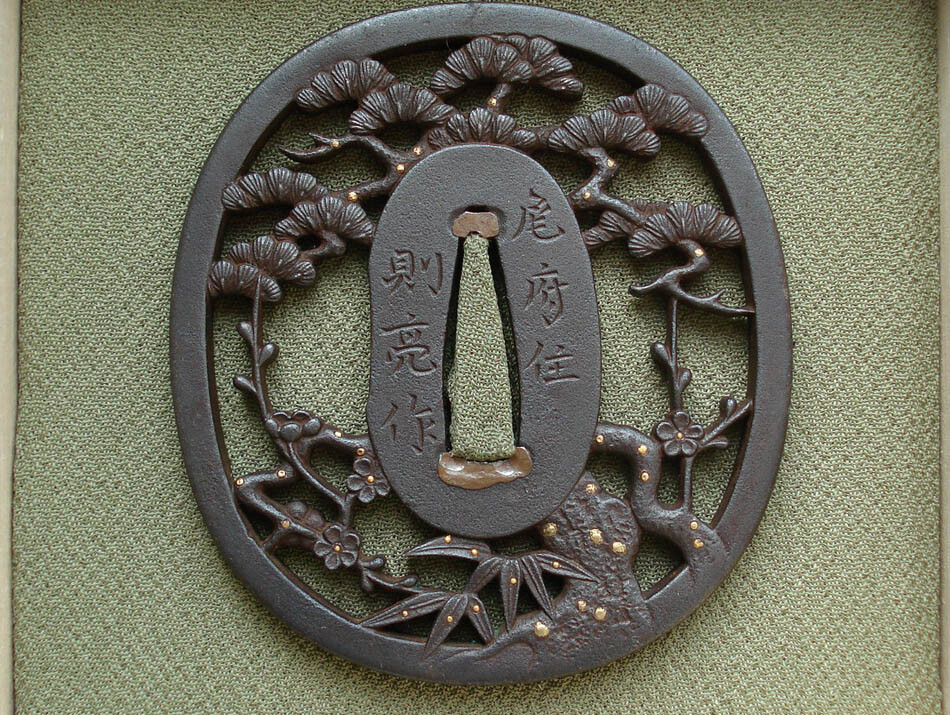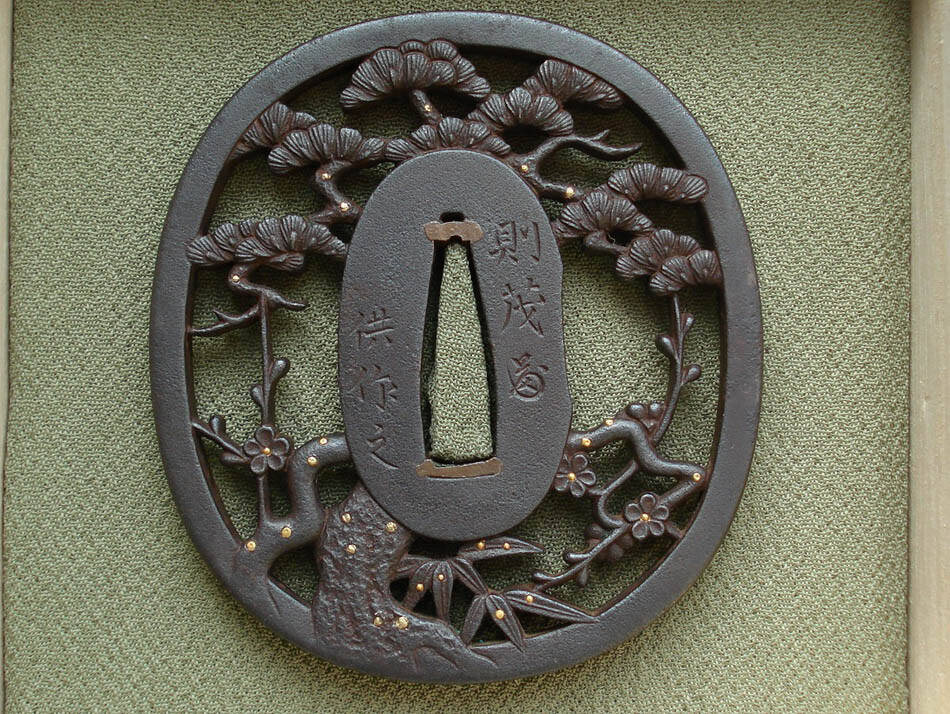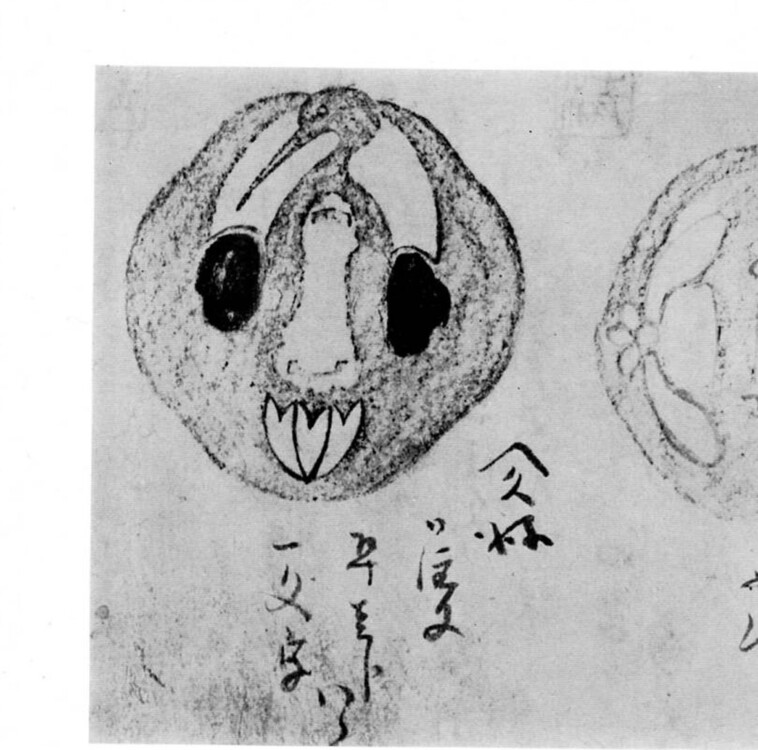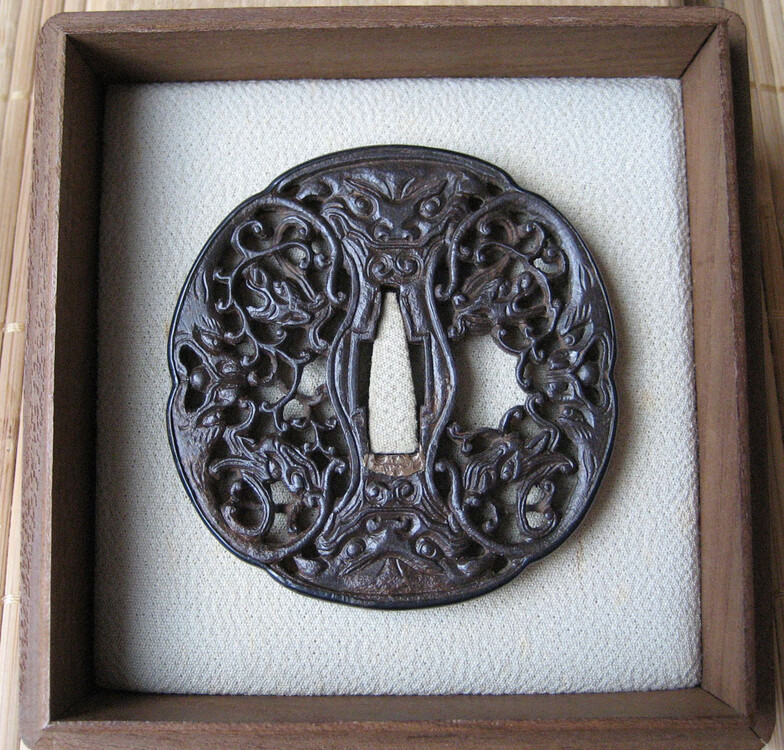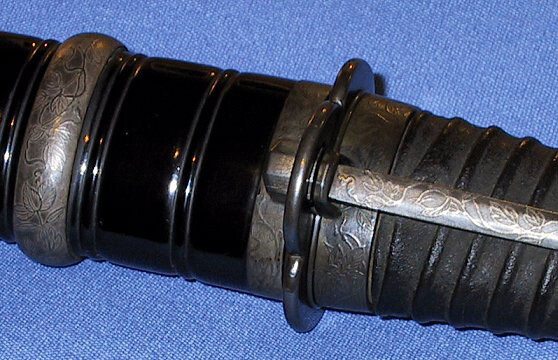-
Posts
4,621 -
Joined
-
Last visited
-
Days Won
23
Content Type
Profiles
Forums
Events
Store
Downloads
Gallery
Everything posted by Curran
-

Translation assistance please on tsuba from Norisuke Book
Curran replied to Curran's topic in Translation Assistance
Yes, that is the book. The Norisuke tsuba I have is the design shown as Shodai's signed 1851 work, but the example I have is done by the nidai with the Nidai's early signature "Norishige". The design is simple, but it is one of my favorite tsuba. Thank you for the Kozenji link. That is a very good blog. I wish to understand any kantei points for Kozenji tsuba, but I find it very difficult other than the heavy use of keyfrett (or old "brocade") design. With the Kozenji tsuba I own, the design is done by gold wire inlaid into the shakudo and polished flat with the shakudo. Maybe this is typical of Kozenji. Curran -

Translation assistance please on tsuba from Norisuke Book
Curran replied to Curran's topic in Translation Assistance
Kiyo-san, (Morita-San) I do not see it as "Sold", but the browser always takes me to English version of the website. :? Well, maybe I helped find this tsuba a good new home or it just was fortunate to sell now. Crane motif is not my favorite, -though I like it paired with longevity turtle. But for some reason I love good Norisuke tsuba, and will wonder if this is really a Norisuke tsuba. I wish I could see it in person. I don't know why I always confuse the "Big Blue Book" and call it the Owari Tosando book when I know the correct name is "Owari to Mikawa no tanko". I purchased the book used from a friend at a good price and it was one of the best book purchases I have made. When I was a foreign exchange student to Japan , I wanted to be sent to the Kyoto area. Instead it is good I was in Nagoya area, as many of the things Nihonto I appreciate are more from this area. This tsuba is in the Owari to Mikawa no tanko book: http://www.sanmei.com/contents/media/tu ... d1575.html It is the face silhouette of a chuby cheeked girl. I like this tsuba and the Kunitomo school, but it is beyond my budget these days. I've been tempted to try and negotiate trade+cash with them, but never know if this is polite. Some dealers don't mind. One or two do. I have only purchased books from this shop. ________________________________________________________________ Morita-san: do you know of any Japanese references or articles on "Kozenji" tsuba (Owari kinko artists)? There is almost nothing in English. I have a tsuba papered to this school, and I continue to look for more information. To the best of my knowledge: There is nothing in English. -

Translation assistance please on tsuba from Norisuke Book
Curran replied to Curran's topic in Translation Assistance
Morita-san (can I say sama if truly grateful ?) Yes, that is the book, though I didn't bother reading the last character. Published by Nagoya NBTHK at some point. For Norisuke, I think the "Big Blue Book" (Owari Tosando ____) is also very good, though I have minor disagreement about their opinion on signature varaitions between Gen1 and Gen2 of the Norisuke family. The Big Blue Book has some nice examples not seen in the Futabayama Norisuke (Ko) book. Curran -
Found the tsuba I was looking for... An Umetada I owned many years ago with some damage. Someone had pried out most of the silver centers to the clematis vine flowers. What I took away from this tsuba and other Umetada school of the time was a high degree of detail but not much depth to the engraving. Also the use of silver or gold and silver dots to give a feel of activity to the engraving. Patina is usually more of a black than a brown. Peter mentioned Kodai (later period) Jingo. I hadn't really thought of that. He considers more the plate surface and the shape. That would be a strike against my opinion of later Umetada, as they are usually relatively smooth surfaced. Ford- thanks for agreeing with me, but they won't make me a shinsa judge in this lifetime...
-
Silver beading and the sort of carving made me think later Umetada. But I would probably expect it to be signed in that case. Generated lots of different opinions on this one.
-

Translation assistance please on tsuba from Norisuke Book
Curran replied to Curran's topic in Translation Assistance
Paul and Morita-san, Here is the link. The tsuba has been up for sale for a while: http://www.sanmei.com/contents/media/tuba_guard1633.htm Appropriately enough, being sold from a shop in Nagoya. Have a go at it if you like. Price is good (just my opinion). I didn't understand the "Ichimonji" until last night. I had forgotten that Ichimonji was one of the many art names of Norisuke. That makes much more sense now. Curran -

Translation assistance please on tsuba from Norisuke Book
Curran replied to Curran's topic in Translation Assistance
Dear Morita-san, Your reading was extremely helpful. I thought I read "Ichimonji", but that I must be wrong. I could not read it all. No, I do not own this tsuba. I have seen this design and it is papered by the NBTHK as "Ono" Tsuba. The "Ono" tsuba does not look like Norisuke workmanship to me, but it is sometimes hard to tell. I like both Norisuke tsuba and Ono tsuba. I keep one good example of each. My collection is small. Some day I hope to find a good example of Norisuke copy of Yagyu "Waves and Moon" style design. Curran Attached: Norisuke tsuba- joint work c.1851-1852 -
I've been hanging back on this discussion, not sure where and if I could add value. Those who know me can depend on me to always harp this: I owned this namban for years. Wish i still did, but sold it out of economic necessity. I've been to Macau and seen the Plataresque church there, then I was in Salamanca in 2002 with the wife. Seeing the Plataresque style there and in Seville connected the dots for me. Animal anthropomorphic figures of western perspective often engraved into spanish and portugese chuch, then they started to show up in Namban tsuba. Didn't much get past tsuba thought, after they knocked down the few Platearesque churches in Japan. Curran (no relation to Curgan that I am aware of yet)
-
The tsuba (sword guard) is beyond help. At one point it was a nice Higo tsuba (Work of the Higo school is appreciated by many, though not my favorite) probably worth a small bit of coin to a collector, but not now. I can 80% imagine what it originally looked like. Regretful, but it is beyond point of restoration or preservation. I don't know the limitations on what was allowed on a sword entering service in WWII, but part of me hesitates to think this tsuba was permitted in a combat zone. The actual story doesn't matter. Others will be better able to comment on the blade than me, and it may or may not warrant restoration. Unfortunately, the tsuba is beyond help.
-

THE PRESENTATION OF A SAMURAI SWORD
Curran replied to Stephen's topic in General Nihonto Related Discussion
Great story to read this morning. I too was surprised they give out no details of the sword: smith or measurements. Giving the timing of the theft- if it was of value and genuine, there is a fair chance it is back in Japan now. Still, in the age of computers one would think the sharing of any remaining record of the sword (oshigata or record of the nakago) would dramatically improve the chances of it being found. Forgive this cross topic recommendation: If anyone would enjoy stories of 1830s /1840s navigation, Massachusetts, Sandwich Islanders, California pre-gold rush, and whaling: I recommend "2 Years before the Mast" by Richard H. Dana. I read this book on a foreign beach long ago, and it left a lasting impression on me. Manjiro's story reminded me of it. -
(1) Harry Watson's translation of the Kodogu Volume. (2) A copy of Bob Haynes Fittings Index (3 vol).. maybe Electronic is available if hardcopy to expensive or undesirable (3) Tsuba: An Aesthetic Study (paperback photocopy that was available fro the Norther California Sword Club for a while). Haynes Index might be getting ahead of things... so try and track down #1 and #3 first as initial primers. Others may recommend better ones off the top of their heads.
-
For the departed teacher, Thank you for that which you shared and taught, from those of us who never met you and still learned from you. Never knew him, but his book was a major stepping stone.
-
I cannot answer Ludolf's original question about how to read the seal on that tsuba. The signature looked very bad to me before I saw the picture of the tsuba, but I guess he wasn't really asking about the veracity. Bumping this up again, hoping that someone else will see and give it a stab.
-
I met him many times over the years at the Tampa show, but it was only in 2007 over a sword I had then and his own Ichimonji that we sat down to talk Bizen and connected. I knew him by reputation as a collector, but I came away from that conversation liking him very much. Two generation of age gap existed between us, but we were kids in a candy store that day. Over and above his distinguished career, I loved the fact that he was so interested in art and explored it. If you go through his website, you'll see he made at least one tsuba in the 1960s. I would have loved to have known individuals like Keith Austin and him then in the 1960s, but it was before I was born. I'll miss him. Curran
-
Yes, I agree the one on Aoi Arts has either lost a cross bar to lock under, or something else. On mine, there is actually a pin inside the box handing down like a stalagtite. The bar itself has a small platform at the end with a cut hole in the middle of it. When sheathed, it clicks into place with the pin going through the hole in the bar like a mekugi through a tsuka and nakago. It locks very clean such that there is absolutely no wiggle movement at all. Unlocks very easy too. There is a little Shimosaka yoroi doshi original to the koshirae that has a habaki made out of the same shibuichi as the fitting (unfortunately, the habaki gets just enough rub from the saya that it does pink up a bit), but the external almost swiss watch like precise locking mechanism is what has always fascinated me. We see all sorts of things on Toppei koshirae. I don't see why it wouldn't be found on a sword some day.
-
That would be my toppei koshirae. I stated in the original post that I kept expecting to see another with locking mechanism, but had not. Sure enough, then the one on Aoi Arts popped up. I agree though that the locking mechanism on the Aoi Arts one doesn't look functional anymore.
-
"just one day from now my talk of today will be the talk of yesterday...or something like that. I can't remember precisely, but the Chinese fortune cookie tasted great." My diet is heavy on fortune cookies.
-
John, Reinhard, Brian, gentlemen: This thread has changed a fair bit from the title. I am late to read through it. Brian, I ask that you don't lock it- as the discussion does not seem heated to me. Reinhard has taken it to a more advanced level and John's post also has a wide field to it. For the most part, I think I should listen (not add noise to a good discussion) in this thread. I agree with much of what Reinhard has said and actually feel he is touching on some things which are best understood by artists who have been taught one way then later encountered another way. But also, more than a choice or understanding of perspective comes the caveman question of technology and tools with the Blackships and everything that followed (I am sorry, but it gets too broad a topic). Be it the button, the clock, the steamship, etc... I've attached an image of a tanto koshirae I own. I acquired it long ago and keep expecting to see something similar in Toppei koshirae of the time <>. The locking mechanism is very functional, yet seems a mix of eastern and western perspective in its engineering. The relevance is just that technology influenced the art as well as the science of perspective. Curran
-
Mostly late late Edo, I believe. I can recall several examples from memory. The only thing to add: more than once a tsuba I've seen in black and white photography from the older books (mostly pre 1980) has turned out to have mother of pearl inlay when seen in real life. This has happened to me a few times. But I cannot recall any from pre 1800. Maybe Ford can. He has a better memory catalog than me, especially for the use of certain materials.
-
Nice Higo or Edo Higo tsuba, and koshirae from the looks of it. Two matching ana are rather common among the Higo design. Curran
-
Mei can be on the left or right side, more depending on the wish of the artist (or forger) signing it. Yes, it is usually on the side with the predominant art facing outward for show- ie. toward the tang so the external observer can see the artwork when sword is worn. Signatures on the seppa dai (central oval support area) are hidden be the tsuka (handle) mounting the sword and not generally seen when the sword is worn. Sometimes a tsuba will be signed on the opposite side (less artistic side facing the blade), but this is the exception to the general rule: most often seen in late period Edo tsuba. I have one tsuba with a dedication covering the seppa dai of the front, so the artist signed it on the backside. To illustrate the Late Edo fact: that tsuba is dated 1856 in the dedication.
-
James H, It was the interface I was using. It was cutting off the bottom of posts. PM message to you too. Curran
-
I would agree. My Echizen Shimosaka very much resembles Peter's in appearance. Rather than be combat driven, it may have been more of a nationalistic en-vogue of some such fashion. Some other interesting pieces of a military symbolistic bent more than functionality seem to originate from that brief period. The example that comes to mind is this: http://www.nihonto.ca/takahashi-nobuhide/index.html I think I saw it in San Fran years ago. Nice piece.



